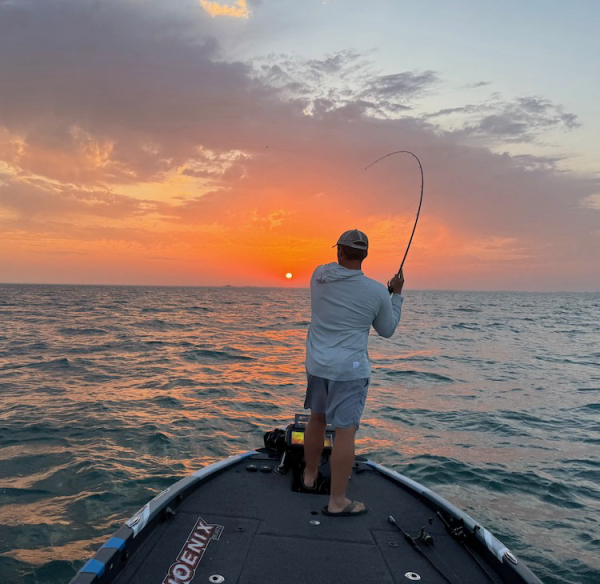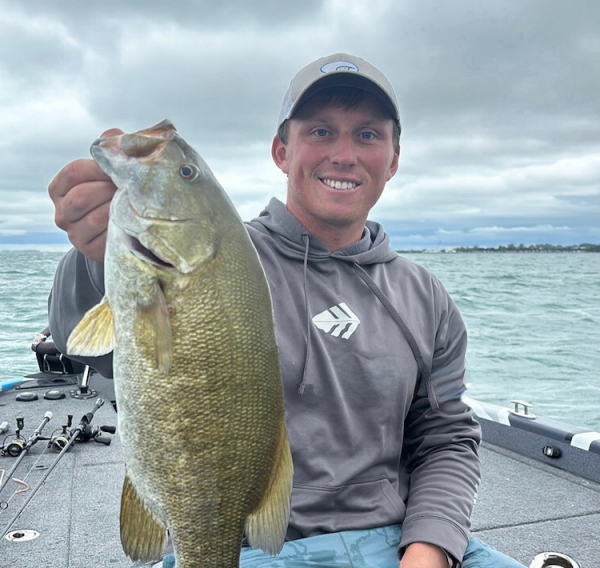

|
Whitewater Fishing B.A.S.S. tournament pro, Alex Redwine, talks fishing the transition period
On most waters, smallmouth bass have either transitioned from post-spawn into summer behavior – or are already in summer mode. Smallmouth bass will spawn in water temperatures between 58 and 70 degrees – and water temps are steadily rising, especially with recent warm spells.
What better way to figure out a program for tracking transition period smallies than talk to a pro angler, in this case, Whitewater Fishing B.A.S.S. tournament pro, Alex Redwine.
Having spent the last week fishing Lake St. Clair, Redwine was thrown into exactly this situation: Where are the bass now that they finished up the spawn? Many anglers are facing the same situation, so we quizzed him on recent and current on-the-water experience fighting the good fight.
“This part of June can always be a tricky time of year. Smallies are just getting off their beds and they get less grouped up as they start moving to their summertime spots,” said Redwine.
“There might be a few leftover fish, but 90% of them are done spawning. They’re in transition and aren’t 100% feeding up yet because the summer water temperatures in a lot of cases haven’t arrived.”
On St. Clair, Redwine found shallow water temps around 69-70 degrees and out a little deeper, in the 62- to 64-degree range. He felt like the deeper water had to warm up more before the fish would really start feeding, as well as the shallower waters warming up a little bit more to get them to start pulling out.
Where to look? Redwine worked both shallower and in-between depths looking for fish, as well as hitting transition spots like points where fish will often group up.
He also discovered a mayfly hatch, something he urges anglers to watch for in late June across the Upper Midwest. “After the spawn, the fish are pretty skinny and wanting to feed up, so if you can find where the mayflies are hatching, you can intercept them feeding on the carcasses, even if they haven’t moved entirely deep to feed up on baitfish.”
Top Presentations
“During this transition period, the first thing I’ll do is throw a 3- to 4-inch swimbait – like a Keitech – something I can cover a lot of water with. The fish can be really spread out during this period but still aggressive, so this is a perfect bait for putting the gas on the trolling motor.”
Redwine says that covering real estate with a swimbait allows him to find out where fish might be starting to group up.
Then, if he gains confidence in an area, Redwine will put the swimbait rod down and pick up a Ned Rig or dropshot rod and really dial into an area.
Dialing into gear, Redwine throws swimbaits and Ned Rigs on a 7-foot medium-power, fast-action rod with a 2500 or 3000 size reel and 10- or 15-pound braid depending on how rocky and snagging the terrain is – which he terminates to either an 8- or 10-pound fluoro leader.
“On St. Clair, the bass will spawn anywhere from 3 to 10 feet of water – and the depth in the middle is 18 to 20 feet – so I caught most of my fish targeting that 9- to 14-foot range because there were still some fish that weren’t fully out deep.”
For anglers stuck in this predicament right now, Redwine suggests mapping where you think the smallmouth spawned and then draw out paths from there – first stops for where the fish will move post-spawn, like a secondary point coming out of a pocket or creek.
“Obviously, you need to intercept them on that path from their spawning site to deeper waters,” noted Redwine. “It can take a lot of looking around.”
Smallie Summer Mode
Redwine says when the water temp in shallower and mid-depths reaches about 75 degrees is when smallmouth bass have transitioned to summer mode and head deeper collectively. That’s when he’ll start fishing deeper, relying heavily on his electronics, and fishing four basic ways – Ned Rig, shakey head, FFS minnow, or topwater.
“And not only is it a water temperature thing that pushes the bass out deeper,” noted Redwine. “They’re following baitfish that are leaving shallower spots and taking up residence over deeper water. Follow the food, find the fish.”
Redwine added that not all his deeper water summer smallie fishing is in no man’s land. A lot of times he’s looking for the shade of deeper banks near shore where the fish will congregate.
“In terms of presentations, my summertime smallie confidence bait is a shaky head. Seems like when the fishing gets tougher, I can always rely on it to put fish in the boat. The other thing is fishing topwaters over the bait high in the water column. When the bass really want to feed up after the spawn you can do some serious damage with a popper or walking bait.”
Stay Comfortable
To follow—and catch—smallies the entire open-water season, an angler must be prepared for cold, snow, rain, and then heat. Redwine says he starts off in the early spring in the Great Lakes Pro Insulated Jacket and Bib, which gives him “excellent range of movement” and “isn’t bulky for how warm it is.”
Then, as spring wears on, he’s never without his Great Lakes Pro Jacket and Bib in case of routine wet, cool, and drizzly weather.
“I’ve put that stuff away for the season, but have been living in my Whitewater Rays Performance Hoodie with the built-in gaiter that protects my face and neck—as well as the rest of me from UV while being in the sun all day. For the same reason, I’m wearing the Prevail Pants to protect my legs. And it’s all super breathable and cool.”
Looking Ahead
Currently on break from B.A.S.S., but looking at two events in August, Redwine has been fishing “a lot of local stuff” and has his fingers crossed to qualify for the 2026 Bassmaster Classic. Whitewater continues to root for the young gunslinger and thanks him for sharing a few tips to catch more smallmouth bass in this time of post-spawn to summer transition.